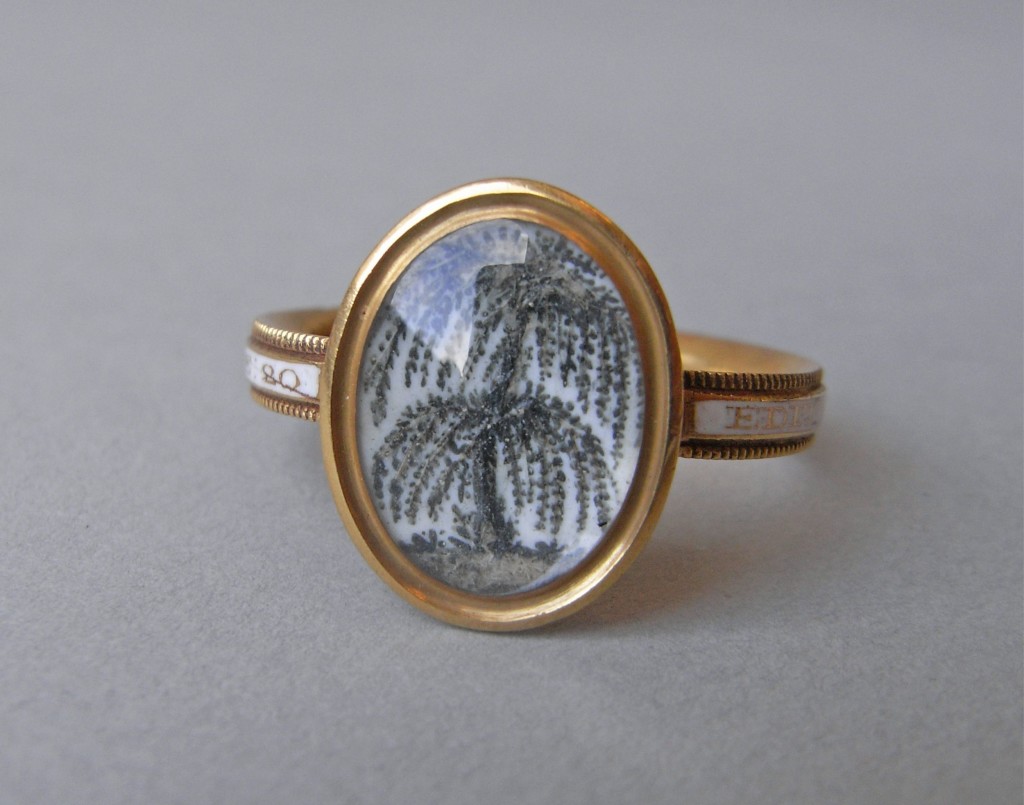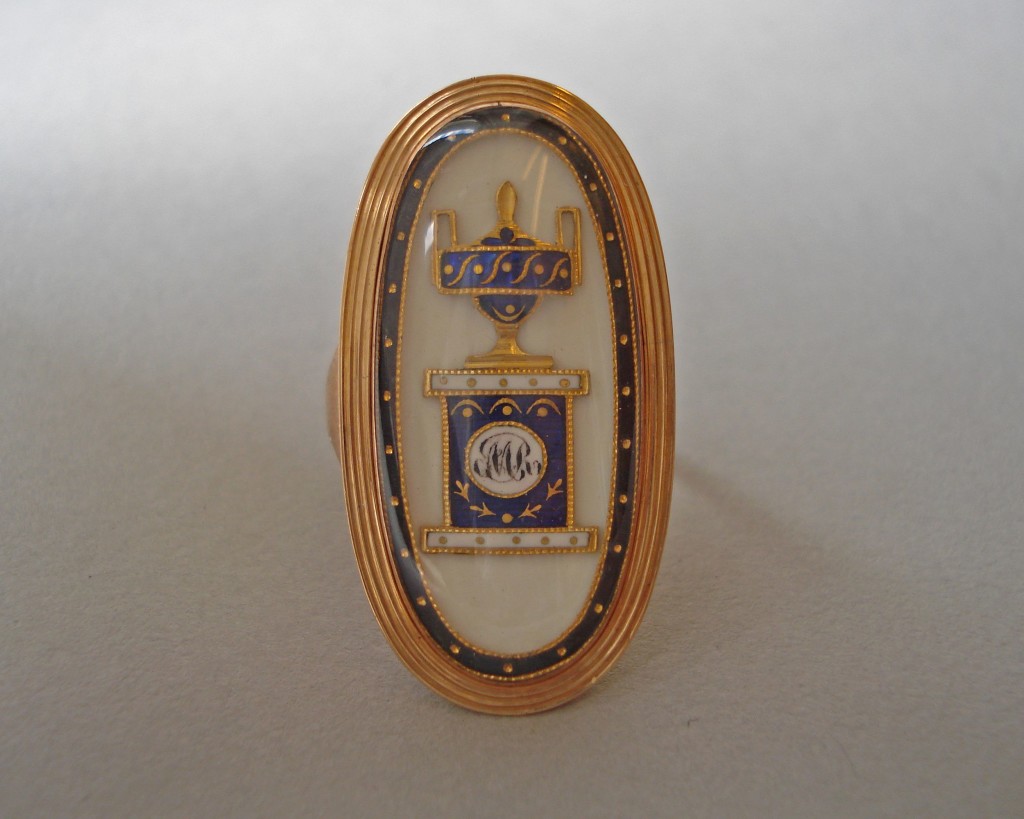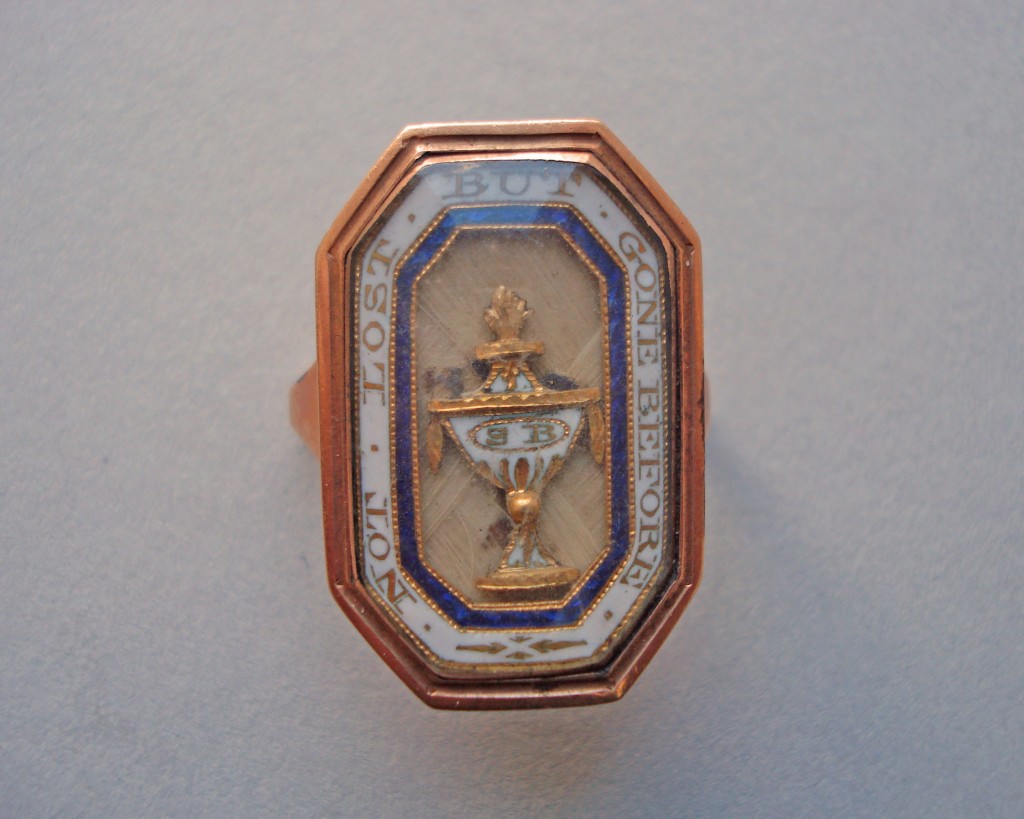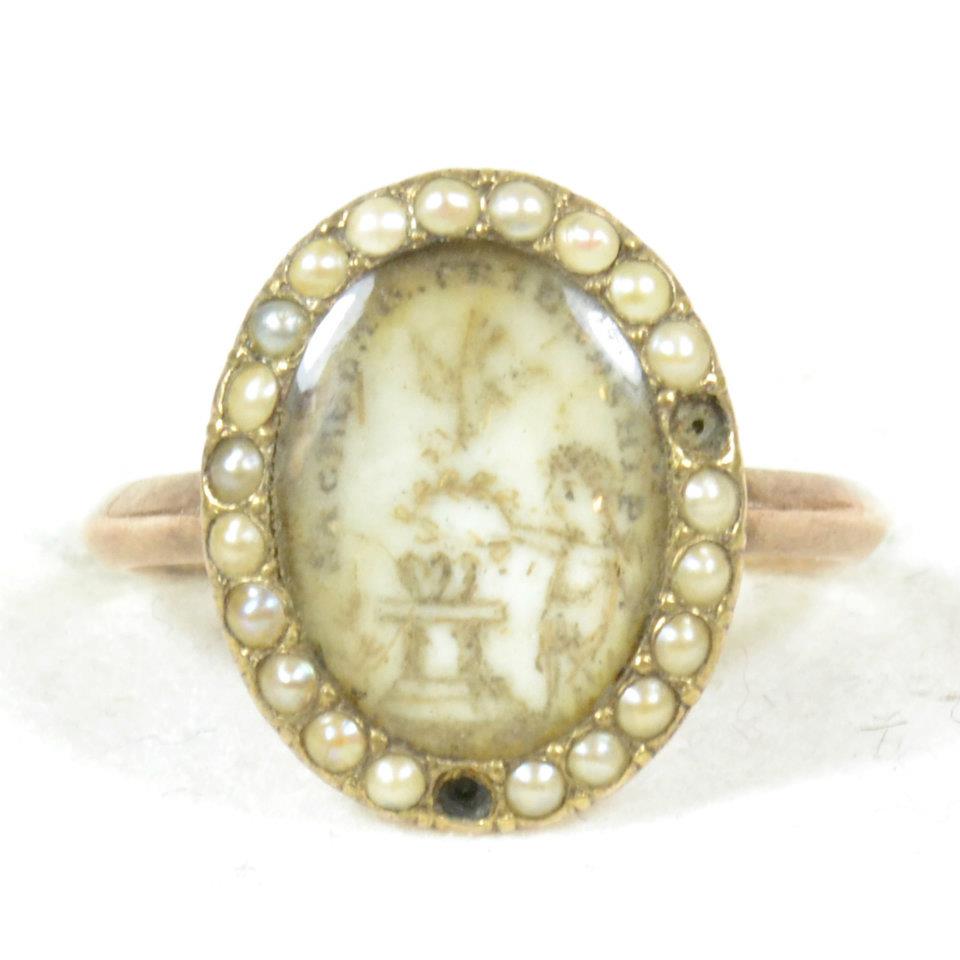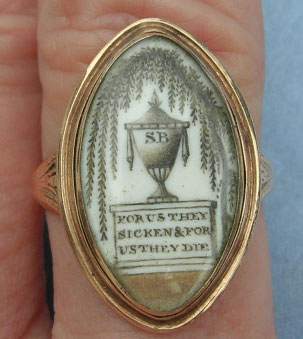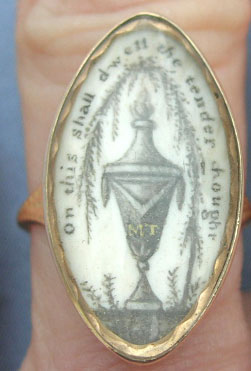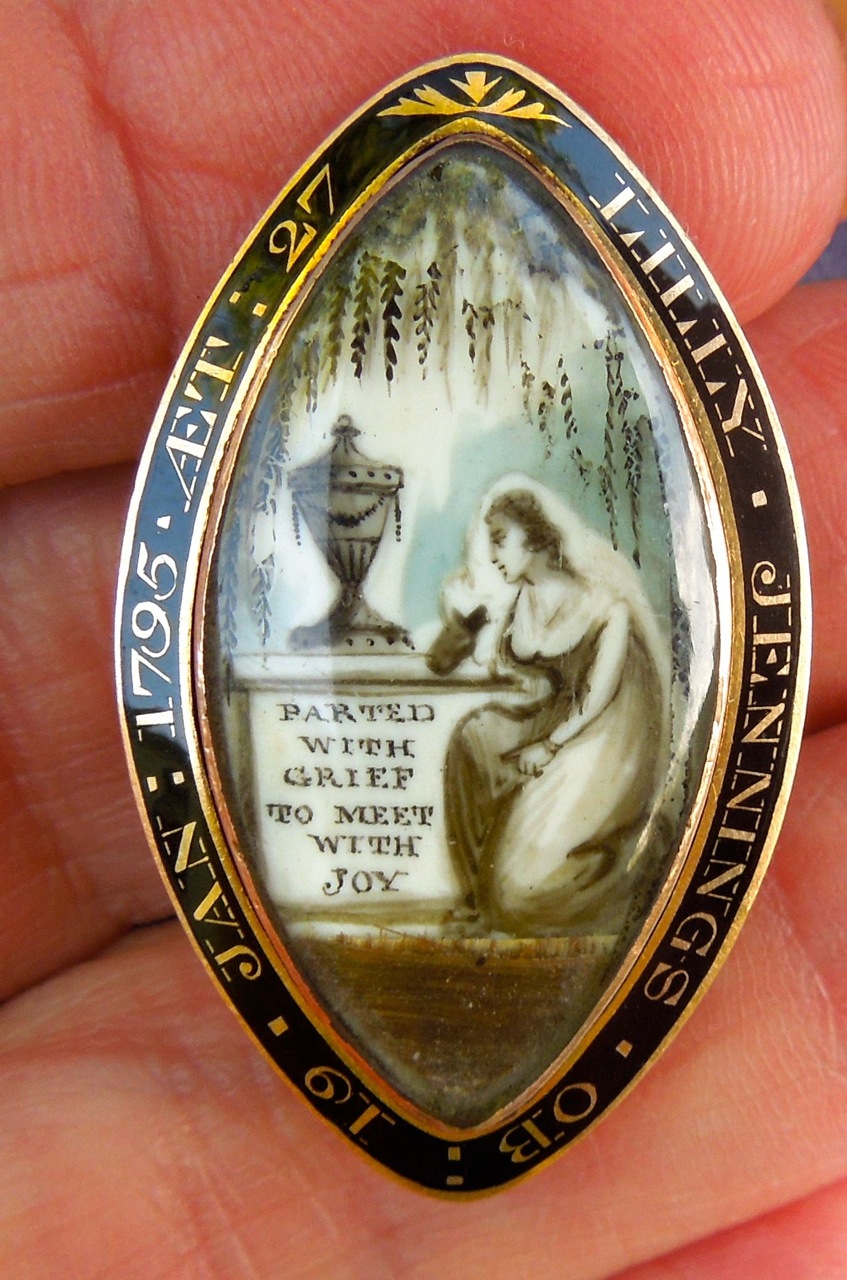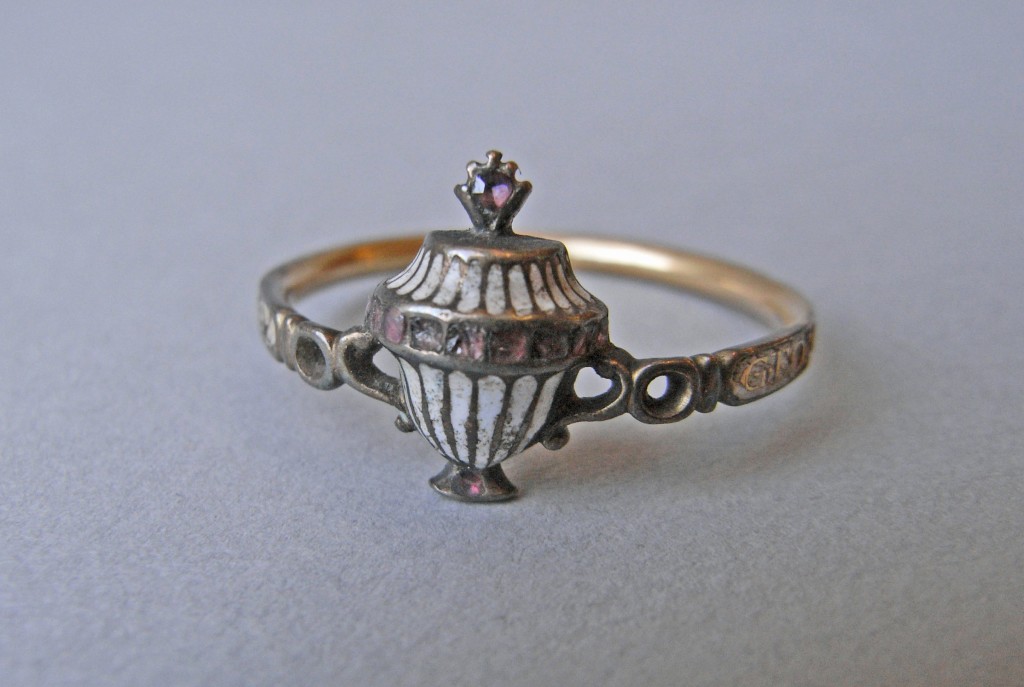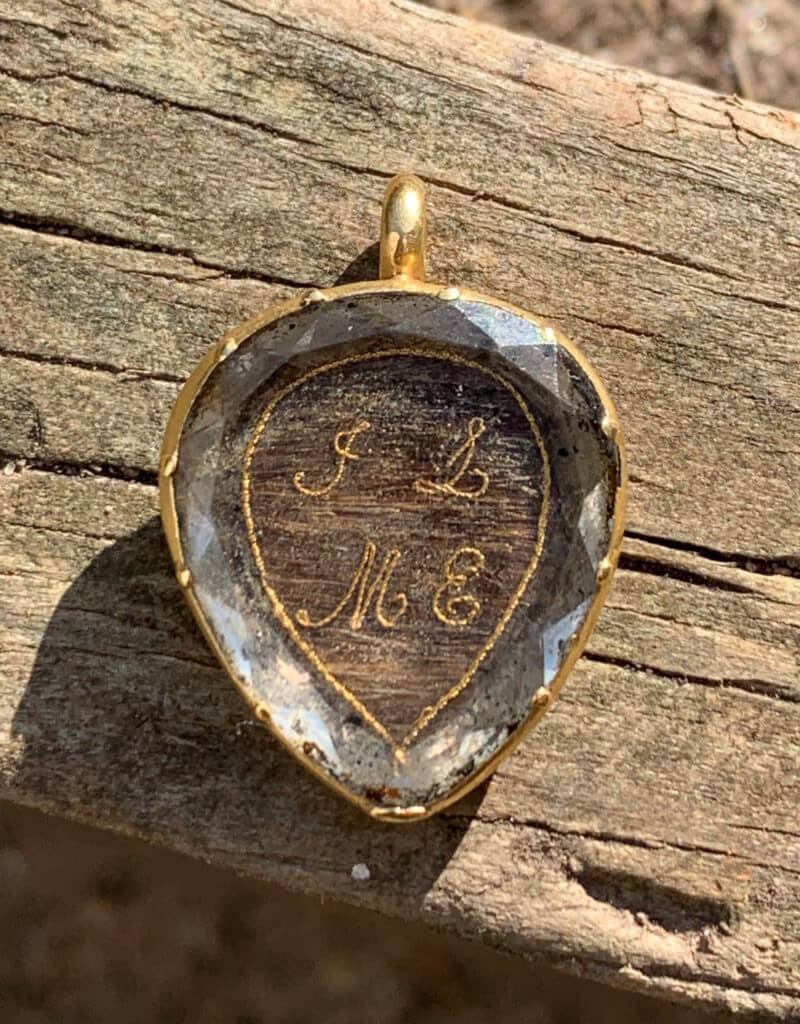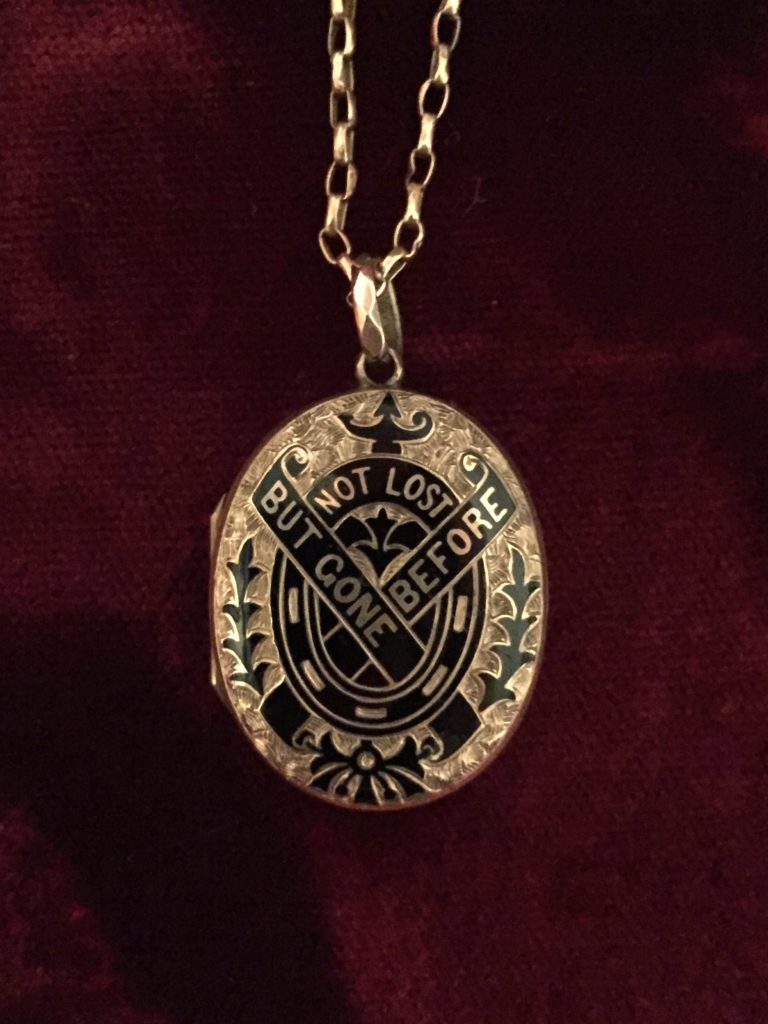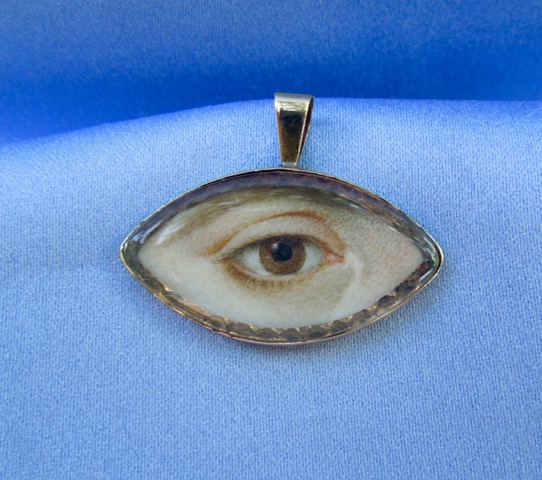Prince Alfred Funerary Urn Locket
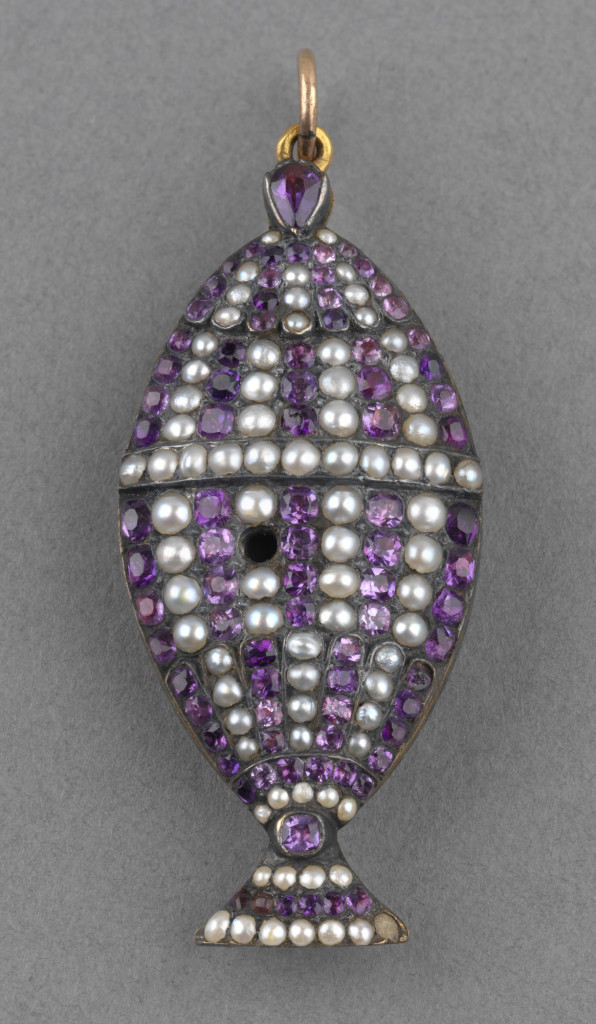
The fourteenth child and ninth son of King George III and Charlotte of Mecklenburg-Strelitz, Prince Alfred was born on the 22nd of September 1780 and died on the 20th of August, 1782. As can be understood, his death at a young age incredibly affected his parents, affecting George III’s mental health. His brother, Prince Octavius, passed on six months later. The common thought of his death was the result of an illness after smallpox inoculation at eighteen months old. Alfred died at Windsor Castle and was buried at Westminster Abbey on the 27th of August, with the Dean of Westminster administrating the ceremony. His body was then taken to the Royal Vault at St George’s Chapel, Windsor on the 11th of February, 1820. Due to his age, there was no official mourning period for Alfred, but his death came at a time of the mourning industry being a necessary part of fashion and a self-sustaining one in its own right.
This locket is a token of memory for Alfred’s family, which shows that regardless of what society may impose, the feeling of grief and the fundamental principal of ‘mourning’ is in effect. There is sadness and love, with the desire to capture the thought of Alfred forever. One of the most affecting elements of this locket is the simple curl of hair in the reverse; there’s not enough hair to capture from the child to do an elaborate weave, just a simple cutting.
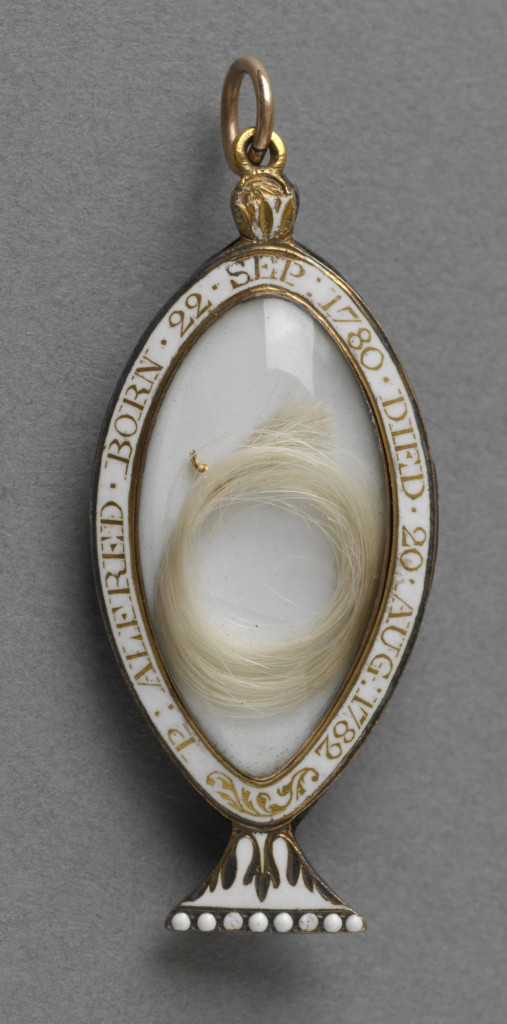
The locket shows the exact symbolism for the mourning of a child, perfectly encapsulated in the message of white enamel. Its reverse is spartan and white, putting more emphasis on the dedication and the hair itself. White enamel is the second most popular mourning material used, next to black enamel. Black enamel, being a colour that has represented death through to pre-history, was (and still is), the colour that was inlaid in jewels, most commonly with the ‘IN MEMORY OF’ sentiment. This was highly standardised by the 19th century, but in the 18th, there was much more flexibility with the use of sentiment and enamel colour.
Death, for its reasons of desecration and entrance into entropy, lead towards black, which in itself, is the absence of light. White, when in use, is the connection to purity, innocence and virginity, show the untarnished representation in colour towards a person’s morals and values. A young person who was not married was seen as unblemished in social status and the use of the white enamel to show this virtue is why white enamel is used in this context.
Colour and symbolism became the primary elements of the mid-18th century, with the introduction of the Rococo period and its infusion of naturalistic designs in jewellery. The previous Baroque period was notorious for its bolder, dominating design, however mourning jewels represent something far more personal than what could be reflected in grander statements of building and architecture.
Cost and the essential nature of wearing a mourning jewel requires that the wearer invest some intrinsic personal affectation into the jewel and that the jewel must reflect something of its time. The 18th century essentially established the industry of mourning, due in part to the Industrial Revolution and the rise of faster methods of production and a society which was becoming more and more mobile, with greater access to education and techniques. Alfred’s locket is constructed for royalty, which is the culmination of all the cultural influences that could be combined into one jewel. It has the potential to show all the artistic flourishes, which could define mourning as a statement, or simply show the personal nature of mourning for a grieving family member.
To see the evolution of artistic talent that made this jewel possible, one must look back to the previous century, where the basis of the industry began. In 1686, the revocation of the Edict of Nantes led to Huguenot goldsmiths and jewellers emigrating to Great Britain. This was when the previous allowance by Henry IV of France provided Calvinist Protestants (Huguenots) significant rights. With this retraction, the Huguenots bought with them skills which enabled the London trade to compete with Paris. This led to greater patronage with the influx of greater designs and new elements of fashion appearing as popular in jewels. By the mid 18th century, much of the values that were carried to Britain were instilled within the new industry and led to such elements as the Rococo designs in jewellery from its continental influence.
After this influx of Huguenot talent, the mourning industry grew along with jewellery development. Mourning rings were flourishing under a stabilised government that had not been seen under the Interregnum (Cromwell) period, as well as the new wealth that was developing from the burgeoning Industrialisation movement.

From the perspective of mourning iconography, this 1782 locket takes the primary ideal motif of the 18th century and turns it into the jewel itself. The urn is a motif that reached incredible heights of popularity in Neoclassicism due to its interpretation from the original classical depictions. It was a motif that was easily lifted from its source and fulfilled all the classical resonance that a revival period needed to convey the style of its respective era. With the focus back upon the personal nature of mourning and the departure of the direct link towards god, death itself became something worn prominently in mainstream fashion. The urn was a perfect way to show this, draped or undraped. Sitting on top of a plinth, column or tomb, the urn is often the central focus of the mourning depiction. The mourning character in the depiction (male or female) is often interacting with the urn in some way, either leaning against it weeping, sitting near it, standing beside it or looking at it directly. This links the personal nature of mourning from the person into the jewel itself. The mourner is the wearer or the person who created the dedication and the urn represents the loved one. Consider that; there’s a direct link in methodology of the urn to the self, this is why the urn is the central motif and not the mourner.
Usage of the urn had never wavered, however. Cremation of the body and the collection of ashes in the urn is a method that survived ancient civilisations well into the Dark Ages. The name itself is derived from the Latin ‘uro’, meaning ‘to burn’, so no matter what the shape of the vessel the title was always ‘urn’. This is a concept that never left the mainstream mind and its uptake as a Neoclassical symbol and its consistency as a funerary motif is simply a natural evolution for the urn’s depictions.
While burial became the more popular method of interment, the urn still retained its status as a symbol of death, testifying the death/decay of the body and into dust and the departed spirit resting with god.
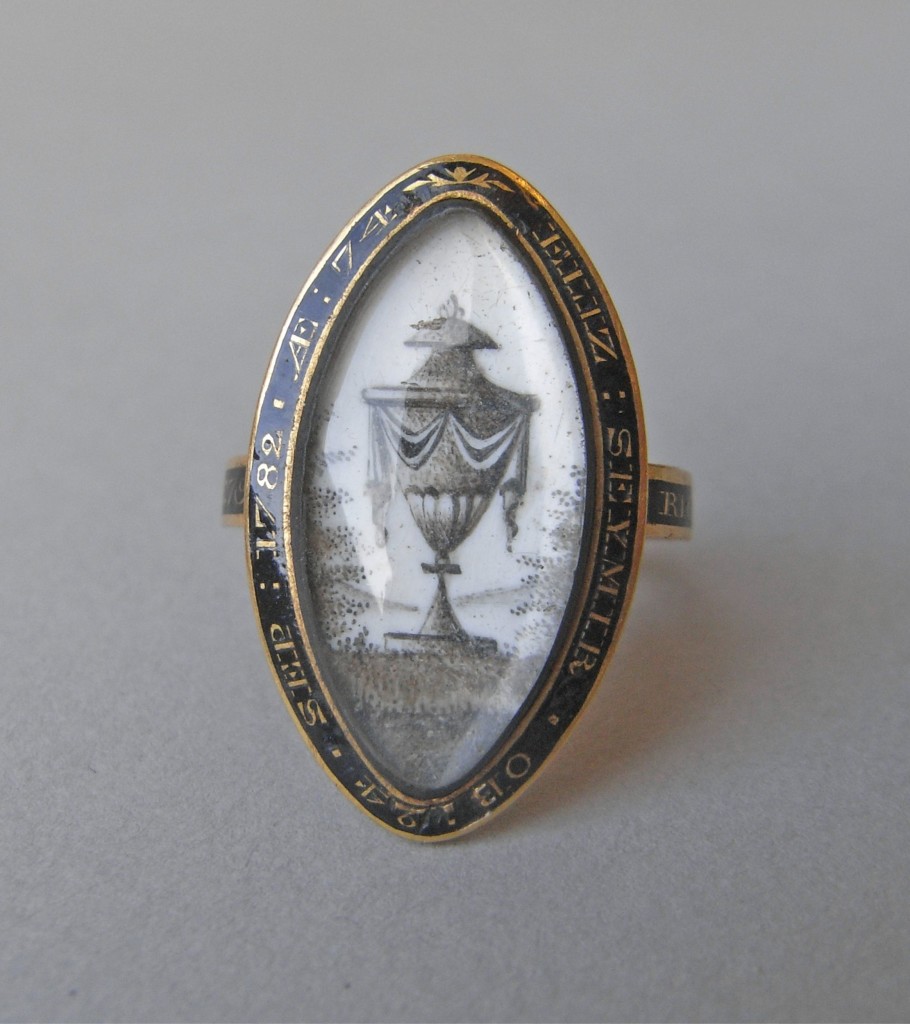
Draped urns are another variation of the popular symbol in the Neoclassical period. The draped urn itself often denotes the death of an older person, however, the drapery is often a constant when in relation to death. Interpretations of this can be when the shroud drapery denotes the departure of the soul towards heaven in relation to the shroud over the body, the drape is the partition between life and death or that it is guarding the sacred contents of the urn itself.
Alfred’s urn is constructed of amethysts and seed pearls, designed in a way to make the piece three dimensional to the viewer. It creates the volume of the urn’s shape through the width by bowing out the design in the convex ’navette’ shape around the sides. It is around the reverse where the white enamel is shown constructing the base of the urn and the hoop. These designs are subtle, but show drapery and fluid dimension to the locket.
Around the border of the urn is the inscription of:
‘P.ALFRED. BORN 22.SEP 1780 DIED 20 AUG 1782’
This was the bespoke element in all of the rings, lockets, clasps, brooches and pendants of the time. A skilled craftsperson could paint this to a specific style in the typography and deliver a jewel that seems perfectly made for the wearer. With many of the jewels in the late 18th century, the designs were created and then tailored to the request of the person who was purchasing the jewel. Much of this is due to the requirements of popular art and fashion.
When the styles become so large and so highly detailed, with miniature portraiture and allegorical scenarios taking popular place, the industry needed to accommodate affordable jewels. Dedications and designs are important to consider when looking at the level of quality in late 18th century mourning jewels, as the dedications can be very pristine and balanced with the art, others can be awkward in comparison. With the Alfred jewel in mind, the following contemporary jewels show the different ways that a jeweller could amend a design to accommodate the commissioned request:
Consider that the following style was popular in the 1770s:
And that the stark white background, typically ivory or vellum (later opaque glass) was the new canvas for the Neoclassical symbols to develop. The Neoclassical period was ushered in through the archaeological discoveries in Herculaneum and Pompeii, providing societies with genuine discoveries of societies locked in time. These classical symbols could be interpreted through jewellery, as seen in the putti/cherub placing the wreath upon hearts sitting upon the unbroken column. Symbolism was now taking the place of traditionally direct statements of love written inside a ring, or mortality being displayed through the memento mori visage of decay and death.
This piece, c.1782, shows how the style developed. In the 1770s, the styles were being pioneered and explored, with rings and pendants finding the shape/size of a canvas that would be most appropriate for the symbols. By the 1780s, it was large enough to accommodate the primary symbols of love and grief, in this case, sharing the urn and plinth, but having an idyllic design for them. This can be seen replicated in such jewels as:
In the above example, it shows how the urn and symbols were developing in 1776. Fashion was learning to adapt to the navette (pointed north to south) shape. Worn at the finger, neck or wrist, the shape perfectly conforms to the body, being ergonomically ideal for daily wearing (many have a convex reverse). With the above pendant, the style is carefully painted. The female character leans against the urn, with the willow awkwardly filling its space inside the border. The text is carefully written around the extremity of the piece, but doesn’t perfectly balance. When considered with the piece of today’s article and the 1782 piece above, this is a style that is still trying to discover a sense of conformity. Neoclassical art had permeated through countries and continents, being more conservative in Catholic regions, but still allegory was the key to identity. This piece doesn’t have the conformity of shape, either, something which would happen rapidly.
And in the above example, the navette style that was to become popular and the standard for wearable jewels of allegorical nature is seen to emerge. The sharpening of the mort hand the south of the piece, as well as more formal design to the urn and the willow allowed for more detailed dedications being painted on the canvas. The 1882 ring shows how this developed to its apex.
Pendants, however, of the larger sort, remained oval in shape. These were displayed, rather than worn, often in their own compact-destined velvet boxes. These sizes became typical in the 1790s, a time when the styles started introducing colour into the mourning depictions. The brown and darker red shades of the sepia colour (signifying body and earth) gave way to muted colour seen in the 1798 pendant. Note how the female mourner is in mourning fashion and there is the introduction of realistic colour, but the earlier sepia style is represented.
In this navette brooch from 1795, the colour representation in the background is unmistakable. Watercolour was leading into the colourful Neoclassical symbols; something that blurred the line between the popular portrait miniatures of the early 19th century and sentimental allegorical depictions.
One of the most common designs that work between these examples is the urn itself. The urn is the primary symbol of Alfred’s pendant and it was one of the most popular of the Neoclassical period. The symbol disappeared soon after the first quarter 19th century in mourning jewels, but was retained within funerary art. The Gothic Revival period played a key role in reverting society back to more ‘traditional’ values. Using a direct relation to the body in the urn conflicts with the burial/god connection which was part of the social understanding of life and death, that Christian values returned to a life under god.
You can find the urn in use to around the 1820s, but many of the latter uses in jewels are anachronistic in the same way that memento mori would have been during the late 18th century. However, in funerary, the urn was still retained and is to this very day. In fact, its use in architecture in the latter 19th century / early 20th century was quite typical, but it had largely disappeared as a motif to represent the self in mourning.
Why Alfred’s locket is so important is because of its status towards royalty and how other jewels cascade from that. It shows a level of wealth and investment that would be seen as a leader in style for others to imitate in 1782. Jewels of the late 18th century are opulent and large, relating closely towards fashion which was rapidly crossing through Europe as the aristocracy invested wealth in dressmakers, a level of artistry that could grow from this wealth, with travelling royalty and aristocracy presenting this fashion into new cultures. Death is never a trivial thing, which makes mourning fashion difficult to value as a cultural aesthetic, but it was something which could be dressed up within the periods of mourning. Death being an inevitability meant that courtiers could design or amend a dress to enter into mourning. In the case of Alfred’s death, there was no mourning period due to age, however the jewel shows a clear outpouring of love and grief into a token of memory.
Gems are the next element to consider in the Alfred locket. From the colour of the gem to the use of their application, this speaks to the affluence and personal sentiment locked in the jewel. This locket has amethysts, which are popular in mourning jewels, particularly from the third stage of mourning. Purple was an important colour for both sentimental and mourning purposes in jewellery of the 19th century, with its underlying meaning of love. This is a factor which became only more prominent as the 19th century wore on with sentimental jewels.
Amethysts were liberally used in mourning jewels of the 1780s, being a common gem that surrounded an oval shaped bezel, which usually held a sepia sentimental painting.
Associated with the Church, due to the the intrinsic connection through the colour purple (robes), amethysts are used in Bishop’s rings and crosses. The purple colour also allows for a third-stage mourning colour to be used in costume after the 1817 statement on Court Mourning by Lord Chamberlain. The religious connection here cannot be overstated, especially post 1840 and with the instillment of family values by Queen Victoria, following on from the Gothic Revival movement. A perfect amethyst should be deep purple and reflect colours of red when turned in the light.
In the post 1860 culture, violet was bought back into the post-mourning environment. First mourning lasted one year and a day, outdoor garments for this would be shown by the plainness and amount of crape, jet jewellery was permitted. After one year and a day, Second stage was introduced. This involved less crape and its application to bonnets and dresses became more elaborate. It was frowned upon if this period was entered into too quickly and it lasted nine months in all. The Third stage (or Ordinary stage), introduced after twenty-one months, involves the omission of crape, inclusion of black silk trimmed with jet, black ribbon and embroidery or lace were permitted. Post 1860, soft mauves, violet, pansy, lilac, scabious and heliotrope were acceptable in half mourning. This period lasted three months. The English Woman’s Domestic Magazine stated that ‘many widows never put on their colours again’ and this was quite a statement for the identity of the woman, which was held under the veil of mourning and family symbolism for the rest of her life. Hats, shawls, mantles, gloves, shoes, fans all changed during mid century, and pagoda sleeves from 1850-70 were fashionable, designed to be stitched to the outer sleeve to cover modesty from the lower arm and wrist. Wide skirts from the 1850s-70s, tie back fashions of the late 1870s and the ‘S-bend’ look of the early 1900s all were adapted to mourning fashion, without a clear definition of difference between them.
What this represents is that a colour used for love and piety could be bought back into the lexicon of fashion and love after a period of mourning, where it had been worn before mourning. While it was not necessarily something that social proprietary allowed to be bought back into daily fashion, the opportunity was there, as it was a colour designed for love.
Discovery and trade led to the desirability of pearls, particularly from medieval and Elizabethan times. ‘Oriental’ pearls, originating from the oyster family, were the most desirable due to their lustre, which pearls from freshwater mussels and conch shells do not have. The Oriental pearls were bought to Europe form the Persian Gulf by caravan traders.
The popularity of pearls reached their height in the late Georgian Era, where clusters of seed pearls were sewn to mother-of-pearl backs with cat gut, some examples can be seen below from the British Museum:
“Oval gold brooch with seed-pearls, in the form of a winged cupid with a lamb, on a base of mother-of-pearl, gesso or plaster; laid onto a background of blue enamel or blue glass and set under a domed glass cover in a gold mount within a pearl border. Inscribed in French.”
“Marquise-shaped pendant with seed-pearls, in the form of sheep and lambs under a tree, on a base of mother-of-pearl, gesso or plaster laid onto a background of blue enamel or blue glass and set under a domed glass cover in a gold mount with blue and white enamel and a tooled gold border. Compartment on reverse with plaited hair under glass.”
“Gold finger-ring with seed-pearls, in the form of a spray of flowers, on a base of mother-of-pearl, gesso or plaster; laid onto a background of blue enamel or blue glass under a domed glass cover in a gold mounted oval-shaped bezel with a pearl border.”
“Marquise-shaped pendant with seed-pearls, in the form of two birds carrying a knotted ribbon, flowers and wheat-ears, on a base of mother-of-pearl, gesso or plaster, laid onto a background of blue enamel or blue glass and set under a domed glass cover in a silver mount with a gold backing, with a border of pastes set in silver and a tooled gold inner rim.”
Seed pearls are a cultural element for Alfred’s locket, being fashionable and sentimental. Their use to create the urn shape on the front of the locket shows the detail of the size of the pearls, from large to small, creating the optical effect of dimension. It s a tribute to to artistry of the time and the access to materials which could allow for its construction.

When these elements are woven together, the narrative of this locket becomes clear. Fundamentally, it was made for a grieving family during a time of difficulty for the British Empire and resonates back into that difficult period by preventing the monarchy from having clear succession. The personality of a jewel is more important than its social and cultural impact, it’s a statement about attachment towards a loved one. Alfred died at a young age, an age that did not allow for the formalities of mourning to be implemented, so this jewel is essentially a piece of Alfred’s family.




